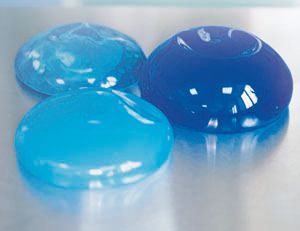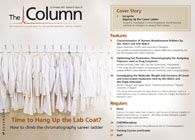Silicone Protheses for Biomonitoring POPs in Humans
Discarded silicone explants, a waste material from the cosmetic surgery industry, could be a new source of sample material for studying POP accumulation in humans.

Scientists from the Norsk Instituutt for Vannforsking (Norwegian Institute for Water Research), Oslo, Norway, have proposed the analysis of silicone explants for the monitoring of persistent organic pollutants (POPs) in humans.1 The team suggest the formation of repositories for discarded silicone implants from the cosmetic surgery industry.
So, where did this idea come from? Lead author Ian J. Allan told The Column that his team has been developing passive sampling methods using silicone to measure environmental POPs for over 10 years. In a recent trial study, the team used a silicone tag in a living fish to measure the contaminants in the river.2 Analysis of the tag showed that levels of POPs were comparable to the levels in the river water, therefore providing proof of concept. Allan said: “Directly comparing concentrations in biota (in units of ng per gram lipids) with concentrations in abiotic compartments, for example in water, (pg/ng per litre) is difficult. The use of the same polymer for sampling different environmental compartments allows the comparison ofthe activity or fugacity of chemicals in these compartments more simply.”
Currently, human biomonitoring of POPs is generally performed using blood, milk, and adipose tissues — the World Health Organization (WHO) and Stockholm Convention are currently working together to survey global human exposure. These samples are difficult and expensive to obtain, whereas explanted silicone from humans is readily available. The paper quotes that an estimated 5–10 million women worldwide are implanted with silicone breast protheses, with300,000 breast augmentations performed in the USA in 2010 alone. As implants have a life-span of 10–15 years, they have to be explanted and are thendisposed of.
Allan said: “In vitro tissue exposure with passive samplingdevices and in vivo methods in clinical settings (for example, with solid-phase microextraction fibres) have received increased attention in recent years and following discussions with my colleagues we realized that it may be possible to use explanted silicone prostheses as passive sampling devices for human biomonitoring.”
With the co-operation and help of a plastic surgeon based in Oslo, Norway, 33 explanted protheses were collected from 22 female clinics undergoing surgery at a clinic in Norway. Acetone was used to extract whole samples — according to Allan, acetone was selected because of the limited effectit has on the swelling of the silicone during extraction compared to nonpolar pentane or hexane. Gas chromatography coupled to mass spectrometry (GC–MS) was subsequently performed to detect organochlorides, polychlorinated biphenyls, and polybrominated diphenyl ethers.
The samples required concentrated sulphuric acid clean-up before GC–MS analysis for acid-resistant chlorinated and brominated substances, limiting the number of compounds that could be detected and investigated. Allan told The Column that the team are now currently working on sample clean-up methods that eliminate this step, and therefore increase the number of chemicals that can be sampled and quantified. The advantage of the method is that samples can be taken from different people but still be directly compared. Allan told The Column: “Ultimately we would like to combine this sampling with non-targeted screening analytical methods.”
The team will be working on developing the study to determine the application of the method to a wider range of silicone samples produced by different manufacturers, in addition to optimizing the method to reduce the level of solvents used and to increase the number of contaminants detectable. - B.D.
References
1. I.J. Allan et al. Environment International59, 462– 468 (2013).
2. I.J. Allan et al. Environ. Sci. Technol. DOI: 10.1021/ es401810r (2013)

Evaluating the Accuracy of Mass Spectrometry Spectral Databases
May 12th 2025Mass spectrometry (MS) can be effective in identifying unknown compounds, though this can be complicated if spectra is outside of known databases. Researchers aimed to test MS databases using electron–ionization (EI)–MS.

.png&w=3840&q=75)

.png&w=3840&q=75)



.png&w=3840&q=75)



.png&w=3840&q=75)









